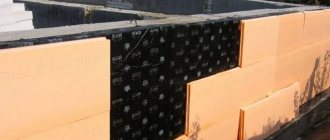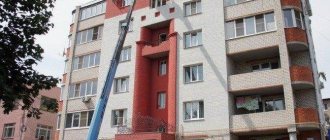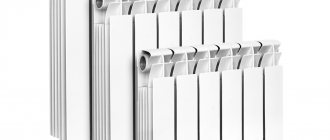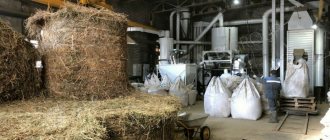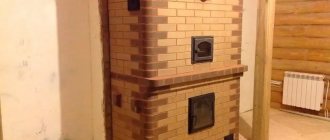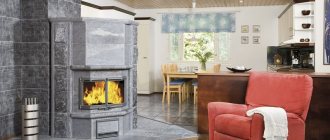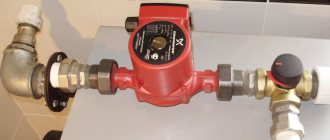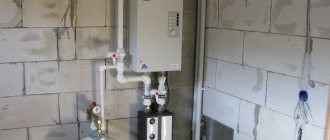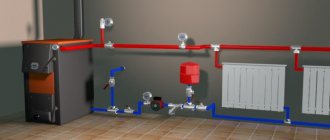When building low-rise housing, brickwork of 1.5 or 2 or 2.5 bricks is used:
- solid single-layer and solid two-layer;
- lightweight two-layer, also known as well.
In any case, polyurethane foam will be useful for increasing the heat transfer resistance of the walls of the house. In other words, it will be cool in the summer and warm in the winter; in addition, the use of polyurethane foam between the walls reduces the consumption of building materials and reduces the load on the foundation and floors.
The photo shows the installation and components for filling the interwall space with polyurethane foam.
Let's take a closer look at how this works. But first, a little theory to understand why polyurethane foam is needed in the space between walls . If theory is not required, then go straight to the question of how to fill the walls with polyurethane foam.
Insulation of walls using polyurethane foam
Pouring polyurethane foam into interwall voids is used to insulate and strengthen the walls of a house under construction or an already in use building. When building houses, brickwork of 1.5 or 2 bricks is used. According to SNiP II-3-79, in order to provide adequate protection from the cold, the wall thickness must be at least 1.2 meters.
It is impractical to use such a number of bricks due to the load on the foundation and the complexity of installation, so the walls are made of two layers. They erect an internal and external one, leaving a space of 50 centimeters between them for free air circulation. This helps retain heat and prevent condensation. But this is not enough for complete insulation. It is difficult to thermally insulate the space between walls using rolled or soft materials. The method of filling voids with polyurethane foam allows you to evenly fill all the gaps inside and between walls.
How does the work happen?
Filling of polyurethane foam is carried out through the lower holes into which the material is supplied under pressure. As the voids fill and the foam hardens, the craftsmen move to the next level. The work continues until the specialists reach the ceiling openings.
Filling with polyurethane foam, in turn, provides a high level of protection against heat loss and cold ingress. Polyurethane foam is able to fill the smallest cracks, making the insulation absolutely airtight.
In addition, we provide waterproofing services for buildings.
12
Years of operation of the company
In the field of insulation and waterproofing
1920
Objects of varying sizes and complexity
190000 m2
Insulated and waterproofed area
4
Professional teams
99%
Satisfied clients
Features of using polyurethane foam for filling
After mixing components A and B, the polyurethane foam for pouring is a plastic mixture. After hardening, it becomes dense and rigid and has a cellular structure. The material is light and hard, does not deform or break.
The thermal conductivity coefficient of polyurethane foam is one of the lowest - 0.022 W/m·K. Therefore, even a small layer of a few centimeters is enough to protect the structure from the cold. Polyurethane foam has high adhesion and is attached to metal, glass, wood, and concrete. Penetrates into pores and cracks, fills them and maintains a uniform structure for 30 years.
Precautions when producing polyurethane foam
Polyurethane foams are harmless and non-toxic, but it is important to know that when they burn, hydrogen cyanide is released, which can cause suffocation and poisoning. It doesn’t matter whether polyurethane foam is produced by pouring or spraying, it is necessary to exclude the presence of open flame sources.
Mandatory security measures:
- Workers must have special clothing and glasses that will protect against splashes on open areas of the body and eyes;
- Respiratory protection with a respirator or helmet mask with air supply;
- Spraying of polyurethane foam is prohibited in the presence of strangers;
- Do not start work on faulty equipment;
- All employees must be given safety training;
- Cover spilled substances with damp sawdust.
Pouring equipment
To fill polyurethane foam walls, pouring complexes are used. Such equipment allows you to accurately dose the components to produce polyurethane foam, mix them until they are homogeneous, and pour them into the space between the walls. Installations come in high pressure (more than 100 atmospheres) and low pressure (4–10 atmospheres).
In high-pressure devices, mixing of components occurs due to penetration into each other. In low-pressure apparatuses, materials are mixed with a special mixer. Air does not participate in this process, because its bubbles lead to the formation of voids inside the matter. The polyurethane foam is applied to the surface using a spray gun.
Low pressure units usually weigh up to 100 kilograms. This makes it easy to move them in space when pouring polyurethane foam into the walls. They are easy to use and can be used at home. Disadvantages include the short length of spray hoses and higher material consumption compared to high-pressure installations.
The performance of high-pressure units allows you to fill large spaces, use hoses up to 120 meters, and avoid the formation of suspension near the spraying site. The disadvantages include the high cost of the equipment, weight more than 100 kg, difficulty of use - a specialist is required to work with the installation.
Features of lightweight brickwork
The walls of brick low-rise buildings are erected 2-2.5 bricks thick. This amounts to 510-640 mm. The parameters are calculated based on the ability of the masonry to conduct and retain heat, as well as calculations of autumn and winter temperatures typical for the area. This type of masonry is called lightweight or well.
The well masonry consists of 2 parallel walls that are connected to each other. Between them is a layer of air that performs thermal insulation functions. The thickness of the outer wall is half a brick, the inner one is 1-1.5. The air layer between them is about 120 mm. This type of masonry is more effective than solid masonry: brick consumption is 40% less, and the wall mass is 28% less. The thermal resistance of the structure increases.
IMPORTANT: well masonry is used exclusively for the construction of external walls of low-rise buildings, or the top floors of apartment buildings, since its strength is low for high-rise buildings.
Examples of high pressure installations:
- Polymer complex PK-60 - capacity up to 60 l/min, self-cleaning filling head, asynchronous gear motor, industrial controller with touch screen;
- Graco HGR - productivity up to 20 kg/min, hydraulic drive, filling controller, automatic determination of the accuracy of the component ratio. Watch the video to see how the Graco installation works using the example of Khimtrust SKZ-20 interwall fill:
- Hennecke - productivity up to 35 kg/min, hydraulic drive, built-in containers of 250 liters, filling head, automatic control of dosing accuracy.
What is polyurethane foam
A new type of insulation for Russia, polyurethane foam, is rapidly expanding its niche in the construction market. Poor knowledge of the characteristics of the material, aggressive advertising by manufacturers and anti-advertising of competitors have led to the fact that this material is full of myths and conjectures, among which not only ordinary consumers, but also professional builders are lost.
This is what foamed two-component polyurethane looks like.
The problems start with terminology. By polyurethane foam insulation, many understand foam rubber, familiar to everyone from childhood. But this is a soft and very elastic type of polyurethane foam, which can be used to insulate entrance doors in a building, but not structural elements. Real insulation is in liquid form.
But even here, consumers and experts make inaccuracies, considering simple polyurethane foam to be the same as polyurethane foam insulation. At first glance, they are right: both materials are made of polyurethane foam. But there is still a significant difference. PPU insulation consists of two components: “A” - polyol and “B” - polyisocyanate. When mixed, they enter into a polymer synthesis reaction with the release of carbon dioxide. The result is a foamed material with a rigid structure and closed cells. Polyurethane foam can be purchased in barrels or pre-filled cylinders.
Polyurethane foam consists of one component, which, when exposed to air, comes into contact with water vapor (which is why there is a recommendation to wet the surface before applying foam) and polymerizes with oxygen, creating open cells of frozen foam. Hence the completely different physical and technical indicators. To make it clear what we are talking about, we present a table with the main characteristics of the materials.
Table 1. Main indicators of polyurethane foam and polyurethane foam.
| Types of polyurethane foam / Indicators | PPU | Polyurethane foam |
| Thermal conductivity, W/(m×°K) | 0,022-0,035 | 0,025-0,045 |
| Number of closed cells, % | More than 90.0 | Less than 50.0 |
| Change in foam volume compared to the beginning of the expansion process | 1 in 40 | 1 to 70-90 |
| Vapor permeability, mg/(m*h*Pa) | 0,02-0,05 | 0,07-0,17 |
| Density, kg/m3 | 20,0-80,0 | 8,0-18,0 |
| Moisture absorption,% | 1,0-3,0 | 10,0-60,0 |
| Compressive strength, kgf/cm2 | 1,53-10,19 | About 1.02 |
| Bending strength, kgf/cm2 | 3,3-19,37 | About 17.0 |
One type of polyurethane foam is polyurethane foam.
The next myth is that the insulation is new, little studied. Therefore, it is better to give preference to a well-tested, albeit not the best, heat insulator.
Indeed, in Russia this type of insulation began to be used only in the mid-90s of the last century. It is finding its niche with difficulty, since consumers still prefer traditional insulation materials: expanded clay, glass wool and basalt fiber wool.
The late appearance of PPU in the CIS countries does not at all mean that it appeared in the countries of Europe and North America at the same time. There it has been known since the late 30s of the 20th century (invented by the German chemist Otto von Bayer). Today, the lion's share of the insulation market in the USA and Europe is occupied by two-component polyurethane foam.
PPU filling technology
There are two approaches for thermal insulation of hollow walls by pouring polyurethane foam. If the building is at the construction stage, the material is poured from above between the outer and inner walls. To do this, choose polyurethane foam with a high start time - 30–45 seconds. For example, “Khimtrust SKZ-30 (slow).” The substance manages to sink down, and then begins to expand, filling all the voids and cracks.
How to fill with polyurethane foam if the building is already in use? To insulate a built house, polyurethane foam is poured between the wall and the cladding from the outside. Typically, a material with a low start time is used - 10–20 seconds. For example, Khimtrust SKZ-20. Holes with a diameter of 12–14 millimeters are drilled in the external wall of the house at the depth of the brickwork. The distance between the holes is 50–100 centimeters. They are placed in a checkerboard pattern. You need to fill the holes with polyurethane foam from the bottom up. This will allow the material to be distributed evenly, without voids inside. After filling, the holes must be closed with wooden dowels to prevent the material from leaking out. Polyurethane foam hardens in 1–2 minutes and forms a dense moisture-proof layer between the inner wall and the cladding of the building.
Our work on this service
Filling the brick with polyurethane foam
Pouring polyurethane foam into the facade of a private house in Moscow
Pouring polyurethane foam into the facade of a private house in the village of Tuchkovo
Filling voids between polyurethane foam walls in Podolsk
Filling voids in walls with polyurethane foam is a good opportunity to insulate a house, apartment, or commercial building. Pouring polyurethane foam allows you to reduce the cost of ongoing construction work and at the same time comply with modern standards for heat conservation. If the building was built a long time ago, but requires thermal insulation, pouring polyurethane foam into the cavities inside the walls will help eliminate heat leaks.
For pouring systems, components are taken that provide increased foam rise time (from 1 minute), with low density (up to 40 kg/m3). Filling must be carried out using special equipment - this is the only way to tightly fill the cavity inside the wall with high-quality lightweight insulation.
Advantages of filling walls with polyurethane foam
The method of pouring polyurethane foam between walls allows you to insulate a building at any stage of construction, as well as during operation, without disturbing the interior decoration of the premises. Polyurethane foam does not shrink, so you don’t have to worry about the integrity of the thermal insulation layer. Water resistance allows you to avoid the formation of cold bridges, condensation, and mold. Components for casting polyurethane foam have a thermal conductivity coefficient from 0.023 W/K to 0.03 W/K. "Himtrust SKZ-30" is suitable not only for heat insulation, but also for sound insulation of inter-wall spaces.
Watch the video for details of pouring polyurethane foam with the Khimtrust SKZ-30 component system.
Khimtrust products are available in 14 warehouses throughout Russia. When ordering components in the online store from a ton, cumulative discounts apply. Delivery throughout the Russian Federation and the CIS.
Advantages of polyurethane foam thermal insulation
Insulation by pouring polyurethane foam is:
- Safely. Hardened polyurethane foam does not emit toxic substances, does not support combustion, and is not attractive to fungi, insects, and rodents;
- Profitable. Lightweight insulation does not weigh down the structure and allows the use of lightweight types of foundations and interfloor ceilings;
- Reliable. Continuous filling provides a monolithic layer of heat insulation, eliminating the appearance of cold bridges.
As a bonus for insulating the house, the owner receives additional sound insulation, because polyurethane foam has the highest sound absorption coefficient among all insulation materials.
Types and areas of use of the material
Polyurethane foam is a popular material that has proven itself in various fields of production and construction. Retains heat well and has a list of advantages:
- A light weight;
- Low thermal conductivity;
- Does not require fastening elements;
- Insulates sound and heat;
- Does not conduct moisture;
- Protects metal structures from rust;
- Inert, prevents the development of mold and bacteria;
Negative properties of polyurethane foam:
- Requires air ventilation to prevent condensation.
- Reacts poorly to ultraviolet radiation and loses its properties. Needs additional cover.
Types of polyurethane foam, load and density:
| Species name | Load kg/cm2 | Density kg/m3 |
| Standard | 60-100 | — |
| Hard | 80-120 | 30-80 |
| Soft | 60-120 | 5-30 |
| Increased rigidity | 60-100 | More than 80 |
| Highly elastic | 100-120 | — |
Closed cell polyurethane foam is a hard sponge with isolated pores filled with gas. Does not allow air and moisture to pass through, retains heat well.
With an open cell - they have a low density of 8-20 kg/m3, allow water and air to pass through, the foam is plastic and soft.
Foam release forms:
- Sheet, in the shape of a rectangle, the thickness of the product varies from 5.0 to 1000 mm. Two types: hard or soft. Individual cutting of the finished product is possible.
- In the form of rolls or reels. Various widths, thickness ranges from 2.0 to 30 mm. May have a synthetic or fabric lining.
- Block - produced in rectangular or cubic shape, hard, there is a crust that is removed during the processing of the material.
- Acoustic – relief tiles of various colors, shapes and sizes. With high sound insulation capabilities.
- Contour – parts of a curved shape, cut out according to the drawing. Designed for filling seats, backs, etc.
- Liquid polyurethane foam – allows you to seal cracks and hollow spaces.
Forms of polyurethane foam
The areas of application of polyurethane foam are extensive and multifaceted. It is actively used in the production of furniture, cars, bedding (pillows, mattresses, blankets), sponges, washcloths. It brings great benefits in the field of construction due to its beneficial properties. Areas in which foam rubber is involved:
- Production of household goods and household appliances;
- Fabric, footwear, furniture industry;
- When insulating pipelines;
- Acoustic insulation;
- Medicine;
- Space industry;
- Cladding of walls, loggias, building structures.
It is used as packaging for fragile, easily breakable items to ensure smooth transportation. Polyurethane foam is used to make elegant interior decor, ventilation filters, shoe insoles and soles. The service life exceeds 40 years, has no restrictions, is hardy in unfavorable environments, and can withstand a wide range of temperature changes. Chemically resistant. Small consumption of the mixture due to the increase in volume allows you to save money without compromising on quality. A promising, safe material, widely used in many areas.
